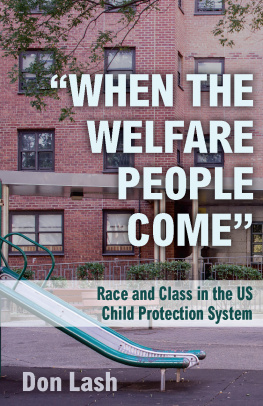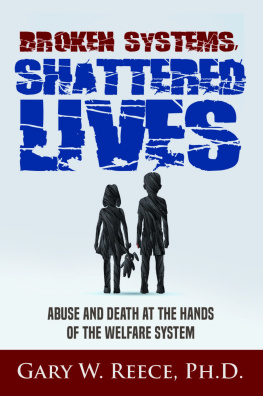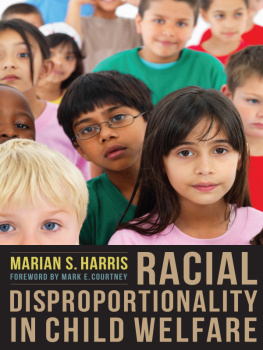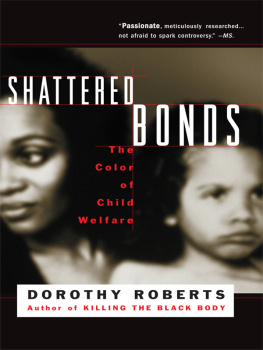One
The Orphan TrainsThen and Now
Origins
T he fear of a dependent and potentially disruptive class of people outside the mainstream of economic life has long been a feature of child welfare and definitely remains so today. In pre-industrial America, there were informal practices to help needy families by providing some basic assistance at the parish or community level, along with the opportunity to place children on farms or as apprentices to provide for their care. Children were economic assets close to home, so there wasnt a need for state intervention or organized charity. As the population grew and became urbanized, and as mass immigration fueled the growth of cities, there was a growing consciousness of the urban poor among the ruling class. Early responses included jailing children for vagrancy, and warehousing them in poorhouses. Motivated in part by fear of producing a criminal underclass, a patrician reformer named Charles Loring Brace created the Childrens Aid Society in New York, which became the model for modern foster care. Brace made the argument that it was more humane to place children in homes than in jail, which is hard to argue with, but the fact that he referred to the children to whom he ostensibly dedicated his lifes work as the dangerous classes gives a not-so-subtle hint about where he was coming from. It was not solelyor even primarilya humanitarian impulse that motivated Brace, but a fear that the elite class he represented would lose control of the growing US cities.
Brace made the argument that the US-born children of foreign
born parents were more dangerous than the unruly proletaires of Europe. In a peculiar formulation of an argument of American exceptionalism, he claimed that the more vibrant atmosphere of American urban life could make the children of immigrants a greater threat to order. In The Life of the Street Rats (1872), Brace wrote:
The intensity of the American temperament is felt in every fibre of these children of poverty and vice. Their crimes have the unrestrained and sanguinary character of a race accustomed to overcome all obstacles. They rifle a bank, where English thieves pick a pocket; they murder, where European proletaires cudgel or fight with fists; in a riot, they begin what seems about to be the sacking of a city, where English rioters would merely batter policemen, or smash lamps.
In appealing for support from his own class, Brace reminded his readers:
These boys and girls, it should be remembered, will soon form the great lower class of our city. They will influence elections; they may shape the policy of the city; they will assuredly, if unreclaimed, poison society all around them. They will help to form the great multitude of robbers, thieves, and vagrants who are now such a burden on the law-respecting community.
Brace claimed he was saving childrenmainly Catholic immigrantsfrom the evil influence of their parents and communities, and placing them with good American Protestant families, preferably far away from the city. He organized groups of children on what became known as Orphan Trains and sent them west in search of homes. (Its noteworthy that only a small percentage of the riders of the Orphan Trains were actually orphans. The popularization of the name is an indication that the existence of biological parents was an inconvenient circumstance for the bourgeois charities.)
The assumption was that handing these children off to strangers with no real vetting was better than providing assistance to their families or placing them with a relative or in their own
communities. Local governments and charitable institutions maintained a distinction between the deserving poor (widows, orphans, workers who became disabled) and the undeserving poor (unmarried mothers, the unemployed). The deserving poor were victims of circumstance and deserved assistance, while the undeserving poor just lacked the moral fiber to help themselves, so any assistance they were given had to be regulated and coupled with moral reeducation. They had to be stigmatized to prevent others from becoming dependent. Foster care for children with living parents was mostly associated with the undeserving poor. In time, Catholic organizations formed to place Catholic children, and Jewish organizations to place Jewish children, but they were modeled on Childrens Aid without the bias toward Protestantism.
The Childrens Exodus
The two-month strike of textile workers in Lawrence, Massachusetts that began in January 1912, later to be known as the Bread and Roses Strike, was a milestone in US labor history. One of the most remarkable aspects of the textile strike was the manner in which the strikers and their allies organized to care for the children of the striking workers. As the strike wore on, the Italian Socialist Federation presented a plan inspired by strikes in Italy but never before used in a US strike. This became known as the Childrens Exodus, and it can fairly be characterized as a working-class form of foster care.
Allies in the labor movement recruited and screened strike
supporting families, and parents and children in Lawrence were prepared for the pain of separation. Two groups totaling more than 250 children left Lawrence. Money was contributed by strike supporters for the care, support, and entertainment of the children. All were seen by doctors, and most made their first trips to zoos, circuses, and museums.
The support of the working class for the exodus was countered by howls of outrage from the government authorities and charitable establishment in Lawrence and beyond. Although no laws had been broken, after the first exodus, the commander of the militia troops guarding the textile mills announced that no further groups of children would be permitted to leave the city. The head of the Massachusetts Society for the Prevention of Cruelty to Children lamented that he had no legal authority to prevent the removals. Mayor Michael Scanlon pronounced that it was the citys responsibility to take care of children if their parents were unable to do so. Showing a stunning lack of appreciation for irony, the mayor of a city in which the use of legal and illegal child labor was ubiquitous accused the strikers of exploiting the children. Newspapers trumpeted the fact that the children had been sent to stay with anarchists and socialists, who would be a corrupting influence on innocent children.
An attempt to send a third contingent was blocked by police, who clubbed parents into submission, arresting some with their children. The judge fined the parents for disturbing the peace, and then sent the neglected children to the local poorhouse to be cared for by the city. While the standards of care were demonstrably lower in the institution than in the homes of the volunteer host families, the children could no doubt be kept safe from radical contamination.
The Childrens Exodus is important not simply as part of the history of the strike but for what it says about bourgeois assumptions about child welfare intervention. The oppressive response illustrates the point that the child welfare systemwhich was still emerging in its modern form in 1912exists in large part to exercise social control over poor families, and to meet the needs of capital before those of families. By demonstrating its own capacity to organize an alternative based on working-class solidarity and respect for parents, the organizers of the exodus had issued a challenge the system was unable to ignore.
The Orphan Train Mentality Today
The arrogance of the system toward poor and working-class parents is still with us, and the Orphan Train mentality is echoed in the treatment of the children of undocumented parents today. A yearlong investigation by the Applied Research Center, the publisher of Colorlines , found that more than five thousand children of undocumented parents were remanded into foster care when their parents were detained for deportation. In one case, a mother learned at the airport that her child would not be accompanying her to Guatemala, and a judge later reasoned that it was undoubtedly in the childs best interest to be raised by a middle-class family in the United States rather than return to an impoverished village in Guatemala with a parent who had committed the crime of crossing the border illegally.
Next page




